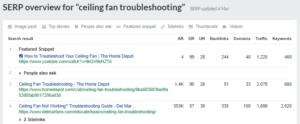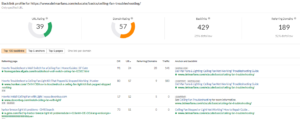Backlinks from other websites are one of the most important signals to search engines that your website is credible. When you link to another website on your website, you increase your website’s credibility in the eyes of the search engine, which encourages search engine crawlers to link to your website. Backlinks, or inbound links, are powerful. They help your site rise in the search engines and can help boost your SEO and rankings.
Not all backlinks are created equal; some backlinks will be better than others. For example, if you spammed forums with links to your site, those wouldn’t and shouldn’t hold more weight than, let’s say, a link from Forbes Magazine. Otherwise, backlinks would just be a game of quantity, and Google’s search results would reward the biggest spammers. Fortunately, ranking on Google doesn’t work that way, and quality backlinks are still a prominent ranking signal.
Here are five (5) important link-building attributes that will help you sort the good from the bad.
- Relevance
- Authoritativeness
- Anchor Text
- REL Attribute
- Link Placement
Now let’s see how these attributes can affect your site.
Relevance
Imagine that you are going to visit Ireland for the first time next month and you need recommendations for places worth going to. Now you have a friend that has lived in Ireland for his entire life and probably knows every nook and cranny. You also have a friend in Canada who hates traveling and has never been outside of Canada. Whose opinion would you hold higher? Certainly, your Ireland friend.
In the same way, links from a website about travel or Ireland would hold more weight than links from sites about marketing or technology because they are more typically relevant and authoritative.
For example, you will see that this page from “delmarfans.com” is ranking number three for the query “ceiling fan troubleshooting.”

If we look at the backlinks and also filter by one link per domain, we can see their backlinks from different websites using any SEO tool of your choice or the Ahrefs free backlink checker tool.
Looking at the backlinks report, you will see this page from homeguides.sfgate.com, which is titled “How to Troubleshoot a Wall Switch for a Ceiling Fan.” So the link is on a very relevant page. On the same page, you will see links from other pages like “how to install ceiling fan with light” from devonbuy.com and “How to Troubleshoot a Ceiling Fan Light Kit That Popped & Stopped Working” from hunker.com, which again is relevant at the page level.

But you can also see that it is relevant at the domain level too, just by looking at their domain name.

Whereas links like the ones from websites like atwoodhats.com, keyworddifficultycheck.com, keyworddensitychecker.com, au-e.com, and 9coupons.net, which are keyword analysis and research tools and so on, are not relevant at all. So an ideal link would be contextually placed within the body of the content where someone is quite literally recommending or referencing you.
Authoritativeness
Authority in the context of backlinks basically represents the so-called “link power” a web page has. And this relates to how Google’s page rank works. As we discussed before, both the quantity and quality of links matter. So the more quality links a page gets, the more PageRank’s it earns. And the more PageRank it has, the more authority it can pass to other pages through hyperlinks.
For example, let’s say that page C has two links, one from page A and one from page B. Page A is stronger than page B and also has fewer outgoing links. Feed this information into the page rank algorithm, and you get the page rank of page C. Now, this is obviously a simplified version of how page rank works, but the key point here is that getting links from high authority pages will likely have the most significant impact on your rankings.
Now while Google doesn’t have page rank or website authority scores, there are two metrics that try to qualify it. These two metrics are
- Domain Rating
- URL Rating
DOMAIN RATING
This is the websites’ authority metric, and it represents the overall strength of a website’s backlink profile. The higher the Domain Rating, the stronger the website’s backlink profile.
URL RATING
This is the page-level authority metric, which represents the overall strength of a page’s backlink profile. You will find both of these metrics throughout most of the SEO tools, giving you insight into referring pages.
At this point, let us talk about the actual link itself, and that will bring us to the final three attributes that make a backlink good or high quality.
WHAT IS A HYPERLINK

The above image is what a link looks like to your website visitors. If we look at the HTML code, then it would look like this: People can understand the process and enjoy it because of the simplicity of animation, just like in the case of <mmoguide=https://mmoguide.net/2d-animation-commercial-ads REL=”nofollow”>Site Explorer</a> and enter your domain name.
There are three basic parts to a link that matter in SEO. They are
- Destination URL
- Anchor Text
- REL Attribute
DESTINATION URL
This is simply the URL the person will visit when the link is clicked. Destination URL can hold a few different parts depending on the nature of the link. If you are sending people to a web page, the Destination URL should be the URL of the page and the link text should be the page title. If your link is sending a person to an email address, the URL is the email address and the link text should be the name of the person you are sending the email to.
ANCHOR TEXT
This is the clickable word, phrase, or image attached to the link. So in our example, “2d animation commercial ads” is the anchor text. Google uses anchor text to better understand what a page is about and what terms it should rank for. Building lots of links with keyword-rich anchors is an example of a link scheme and may result in a Google penalty as it looks unnatural.
For example, if you had a post on the “Best hockey Balls” and have a hundred links pointing to it where the anchor texts are all hockey balls, then it would look and be quite unnatural. Commonly used anchor texts are: The Company’s brand name, the title of the page, the URL, or phrases like “click here.” With most earned links, you have very little or no control over the anchor text, so over-optimization isn’t something you really need to worry about.
REL ATTRIBUTE
Some links contain a REL attribute, which is intended to tell crawlers about the relationship between the linking page and the linked page. And the three REL values that you should know about when it comes to link building are Nofollow, UGC, and sponsored.
Historically, nofollow links told Google that the linking page would rather not associate itself with the linked page. For that reason, Google didn’t transfer authority through those links. But then Google added a couple of other REL values: UGC, which stands for “user-generated content,” and sponsored, which signifies an ethical paid link. They also announced that from now on, they would look at these link attributes as “hints,” meaning they may pass value through them at their discretion.
Now, if a link doesn’t have any of these REL values, then it would be called a followed link meaning the link can pass page rank and help boost your rankings. This is still relatively new, but I would recommend focusing on building followed links, although that’s only partially within your control. Now it’s important to note that nofollow and UGS links aren’t bad. It’s just that followed links are proven to pass authority.
LINK PLACEMENT
Prominent links are more likely to be clicked, and it’s believed that Google takes this into account when determining how much authority a link transfers. For instance, an editorial link is more likely to be clicked than a link in the footer. So all else being equal, the former would be better than the latter.
So to summarize, an ideal link would come from a relevant and authoritative page, where the link is followed. It would have a descriptive anchor and be placed contextually between editorial content. But the truth is that a lot of this is out of your control.
What is in your control is how you spend your time building links by using the attributes mentioned in this article to help qualify prospects or people that are worth contacting; you will spend your time building links that will actually move the needle. The easiest way for a beginner to start building links is to use tried and tested tactics.




Pingback: 3 LINK BUILDING TACTICS FOR BEGINNERS - MMO Guide